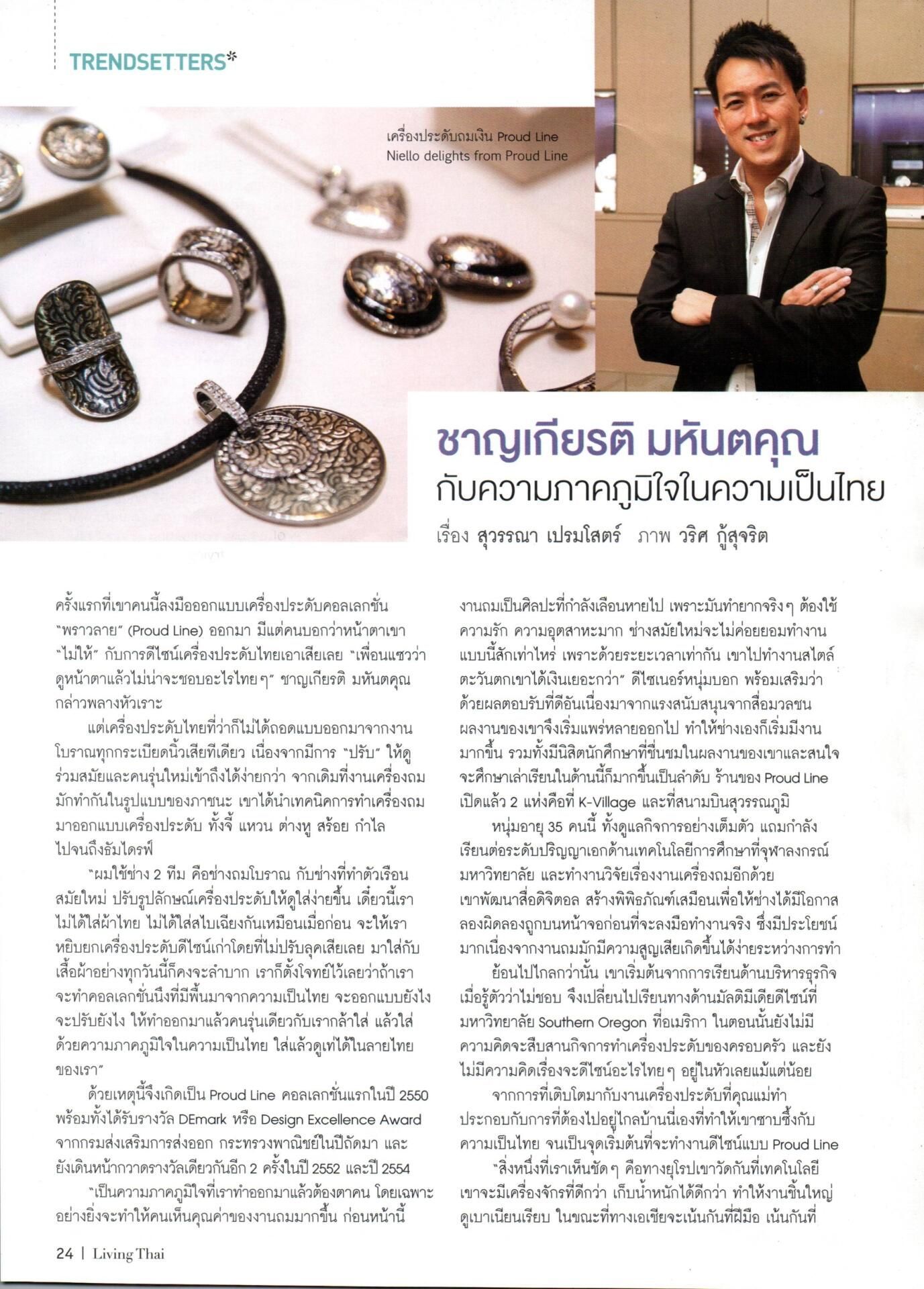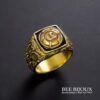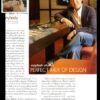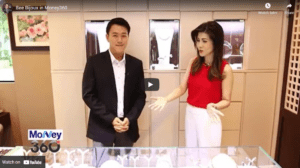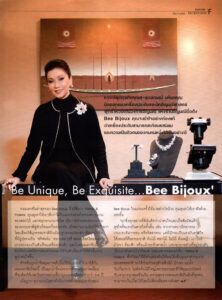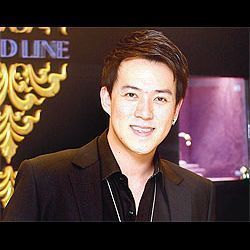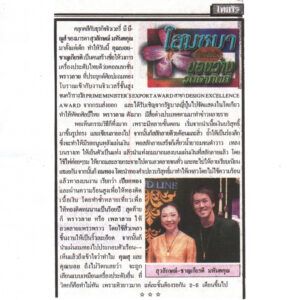ชาญเกียรติ มหันตคุณ กับความภาคภูมิใจในความเป็นไทย
ครั้งแรกที่เขาคนนี้ลงมือออกแบบเครื่องประดับคอลเลกชั่น ”พราวลาย บาย บี บิจูส์” (Proud Line by Bee Bijoux) ออกมา มีแต่คนบอกว่าหน้าตาเขา “ไม่ให้” กับการดีไซน์เครื่องประดับไทยเอาเสียเลย “เพื่อนแชวว่า ดูหน้าตาแล้วไม่น่าจะชอบอะไรไทยๆ” ชาญเกียรติ มหันตคุณ กล่าวพลางหัวเราะ
แต่เครื่องประดับไทยที่ว่าก็ไม่ได้ถอดแบบออกมาจากงานโบราณทุกกระเบียดนิ้วเสียทีเดียว เนื่องจากมีการ “ปรับ” ให้ดู ร่วมสมัยและคนรุ่นใหม่เข้าถึงได้ง่ายกว่า จากเดิมที่งานเครื่องถมมักทำกันในรูปแบบของภาชนะ เขาได้นำเทคนิคการทำเครื่องถมมาออกแบบเครื่องประดับ ทั้งจี้ แหวน ต่างหู สร้อย กำไล ไปจนถึงธัมไดร์ฟ
”ผมใช้ช่าง 2 ทีม คือช่างถมโบราณ กับช่างที่ท่าตัวเรือน สมัยใหม่ ปรับรูปลักษณ์เครื่องประดับให้ดูใส่ง่ายขึ้น เดี๋ยวนี้เรา ไม่ได้ใส่ผ้าไทย ไม่ได้ใส่สไบเฉียงกันเหมือนเมื่อก่อน จะให้เรา หยิบยกเครื่องประดับดีไซน์เก่าโดยที่ไม่ปรับลุคเสียเลย มาใส่กับ เสื้อผ้าอย่างทุกวันนี้ก็คงจะลำบาก เราก็ตั้งโจทย์ไว้เลยว่า ถ้าเราจะทำคอลเลกชั่นนึงที่มีพื้นมาจากความเป็นไทย จะออกแบบยังไง จะปรับยังไง ให้ทำออกมาแล้วคนรุ่นเดียวกับเรากล้าใส่ แล้วใส่ด้วยความภาคภูมิใจในความเป็นไทย ใส่แล้วดูเท่ได้ในลายไทยของเรา”
ด้วยเหตุนี้จึงเกิดเป็น Proud Line by Bee Bijoux คอลเลกชั่นแรกในปี 2550 พร้อมทั้งได้รับรางวัล DEmark หรือ Design Excellence Award จากกรมส่งเสริมการส่งออก กระทรวงพาณิชย์ในปีถัดมา และ ยังเดินหน้ากวาดรางวัลเดียวกันอึก 2 ครั้งในปี 2552 และปี 2554
“เป็นความภาคภูมิใจที่เราทำออกมาแล้วต้องตาคน โดยเฉพาะ อย่างยิ่งจะทำให้คนเห็นคุณค่าของงานถมมากขึ้น ก่อนหน้านี้ งานถมเป็นศิลปะที่กำลังเลือนหายไป เพราะมันทำยากจริงๆ ต้องใช้ ความรัก ความอุตสาหะมาก ช่างสมัยใหม่จะไม่ค่อยยอมทำงาน แบบนี้สักเท่าไหร่ เพราะด้วยระยะเวลาเท่ากัน เขาไปทำงานสไตล์ตะวันตกเขาได้เงินเยอะกว่า” ดีไชเนอร์หนุ่มบอก พร้อมเสริมว่า ด้วยผลตอบรับที่ดีอันเนื่องมาจากแรงสนับสนุนจากสื่อมวลชน ผลงานของเขาจึงเริ่มแพร่หลายออกไป ทำให้ช่างเองก็เริ่มมีงานมากขึ้น รวมทั้งมีนิสิตนักศึกษาที่ชื่นชมในผลงานของเขาและสนใจจะศึกษาเล่าเรียนในด้านนี้ก็มากขึ้นเป็นลำดับ ร้านของ Proud Line by Bee Bijoux เปิดแล้ว 2 แห่งคือที่ K-Village และที่สนามบินสุวรรณภูมิ
หนุ่มอายุ 35 คนนี้ ทั้งดูแลกิจการอย่างเต็มตัว แถมกำลังเรียนต่อระดับปริญญาเอกด้านเทคโนโลยีการศึกษาที่จุฬาลงกรณ์มหาวิทยาลัย และทำงานวิจัยเรื่องงานเครื่องถมอีกด้วย เขาพัฒนาสื่อดิจิตอลสร้างพิพิธภัณฑ์เสมือนเพื่อให้ช่างได้มีโอกาสลองผิดลองถูกบนหน้าจอก่อนที่จะลงมือทำงานจริง ซึ่งมีประโยชน์มากเนื่องจากงานถมมักมีความสูญเสียเกิดขึ้นได้ง่ายระหว่างการทำ
ย้อนไปไกลกว่านั้น เขาเริ่มต้นจากการเรียนด้านบริหารธุรกิจ เมื่อรู้ตัวว่าไม่ชอบ จึงเปลี่ยนไปเรียนทางด้านมัลติมีเดียดีไซน์ ที่มหาวิทยาลัย Southern Oregon ที่อเมริกา ในตอนนั้นยังไม่มีความคิดจะสืบสานกิจการทำเครื่องประดับของครอบครัว และยังไม่มีความคิดเรื่องจะดีไซน์อะไรไทย ๆ อยู่ในหัวเลยแม้แต่น้อย
จากการที่เติบโตมากับงานเครื่องประดับที่คุณแม่ทำ ประกอบกับการที่ต้องไปอยู่ไกลบ้านนี่เองที่ทำให้เขาซาบซึ้งกับความเป็นไทย จนเป็นจุดเริ่มต้นที่จะทำงานดีไซน์แบบ Proud Line สิ่งหนึ่งที่เราเห็นชัด ๆ คือทางยุโรปเขาวัดกันที่เทคโนโลยี เขาจะมีเครื่องจักรที่ดีกว่า เก็บน้ำหนักได้ดีกว่า ทำให้งานชิ้นใหญ่ดูเบาเนียนเรียบ ในขณะที่ทางเอเชียจะเน้นกันที่ฝีมือ เน้นกันที่ความประณีตของการใช้มือทำ เน้นความสามารถของช่าง” เขาอธิบาย พร้อมให้ความเห็นว่า ด้วยความที่เครื่องถมและความเป็นไทยอยู่ใกล้ตัวเราเกินไป เราจึงมักมองข้าม แต่เมื่อมีโอกาลได้มองมาจากช้างนอก บวกกับได้เจอเพื่อนต่างชาติที่ทึ่งกับความเป็นไทยเป็นอย่างมาก เขาจึงเริ่มหันมาเห็นคุณค่าความเป็นไทย
“มันเป็นตัวตนของเรา เป็นสิ่งที่บรรพบุรุษเราได้ทำไว้แล้วก็สืบสานต่อกันมา เรามีประวัติศาสตร์ที่ยาวนานกว่าหลายประเทศ ส่วนเรื่องรายละเอียดและความประณีตในฝีมีอเชิงช่าง ประเทศไทยไม่แพ้ใครเลย” เขาย้ำถึงความสำคัญที่คนไทยจะต้องภูมิใจในความเป็นไทย
“คุณแม่เป็นคนเริ่มต้นงานถมก่อนเป็นชิ้นแรกๆ คุณแม่ ไปสอนหนังสืออยู่ที่กาญจนาภิเษกวิทยาลัย ช่างทองหลวง ซึ่งจัดตั้งขึ้นตามแนวพระราชดำริในสมเด็จพระเทพรัตนราชสุดาฯ สยามบรมราชกุมาร ได้ไปเจอกับช่างถมก็เลยทำออกมาชิ้นนึง ผมก็เห็นว่า เอ๊ะ อันนี้มันต่อยอดได้อีกเยอะเลยนะ”
เขายังมองทะลุว่าคุณสมบัติเฉพาะตัวของภาชนะเครื่องถมนั้น ตรงกับคุณลักษณะความเป็นเครื่องประดับที่ดีคือหนึ่ง สวยงาม และสอง คงทน อีกด้วย
สันนิษฐานกันว่าโปรตุเกสเป็นผู้นำศิลปะเครื่องถมเช้ามายัง ประเทศไทยเมื่อกว่า 500 ปีก่อน ในขณะที่บางทฤษฎี ก็ยืนยันว่า เครื่องถมเป็นหัตถศิลป์ดั้งเดิมของไทยที่มีศูนย์กลางอยู่ที่เมีองนครศรีธรรมราชนี่แหละ ในอดีต ก็มีการนำศิลปะเครื่องถมมาทำเป็นเครื่องประตับ แต่ส่วนใหญ่มักจะเป็นงานแบบประเพณี
การทำเครื่องประดับของชาญเกียรติ เริ่มจากขั้นตอนที่เหมีอนกับการทำเครื่องถมโบราณ นั่นคือเริ่มจากนำเนื้อเงินมาขึ้นรูปและวาดลวดลาย นำค้อนกับสิ่วมาสลักให้เป็นร่อง พักไว้ จากนั้นเตรียมน้ำยาถมโดยนำทองแดง เงิน และตะกั่ว มาเคี่ยวจนเป็นโลหะสีดำ และถมโลหะลีดำลงในร่องเงินที่สลักเอาไว้ ตะไบส่วนที่เกินออก จนเห็นผิวเครื่องประดับเป็นโลหะสองชนิดคือเงินกับน้ำยาถม หลังจากนั้นนำไปขัดเงา แล้วจึงมาถึงขั้นตอนที่ยากมากนั่นคือนำทองคำบริสุทธิ์หลอมให้อยู่ในสถานะของเหลว เพื่อนำไปทาลงบนชิ้นงาน แล้วจึงนำไปเผา ทาใหม่ แล้วเผาอีก ทำซํ้าแบบนั้นหลายครั้ง จนทองซึมลึกลงไปในเนื้อเครื่องประดับมาถึงขั้นตอนสุดท้ายคือนำค้อนกับสิ่วมาเคาะเป็นริ้วลาย ขั้นตอน สุดท้ายนี้เองเป็นบทพิสูจน์ว่าทองซึมลงไปลึกจริง ๆ ไม่ใช่แตะ อยู่แค่พื้นผิวด้านบน
ขั้นตอนสุดท้ายที่เรียกว่าการ “เพลาลาย” ซึ่งชาวปักษ์ใต้จะ พูดเป็น “เพราลาย” และต่อมาจึงเพี้ยนเป็นคำว่า “พราวลาย”
เราสงสัยว่า การนำกรรมวิธีของเครื่องถมมาใช้อย่างร่วมลมัย ในแบบคอลเลกชั่นฃองเขานั้น ดูจะยากกว่าการทำภาชนะแบบงาน โบราณ คำาตอบที่ได้คือ “ช่างจะบ่นมากกว่า”
“ช่างจะบ่นมากกว่า เพราะไม่มีที่ให้จับ มันจับยาก ทำงานยากกว่าครับ” เขาหัวเราะ พร้อมเฉลยด้วยว่ากรรมวิธีการทำเครื่องถม เมื่อทำเสร็จเรียบร้อยแล้วจะโดนความร้อนสูงๆ อีกไม่ได้ การนำมาเช้าตัวเรีอนจึงต้องมีเทคนิคเฉพาะที่ทำให้เครื่องประดับไม่โดนความร้อนสูงจนเกินไปนัก นอกจากนั้นเขายังใช้เพชรและมุกมาประกอบงานถมอีกด้วย
“ใช้เพชรเพื่อยกระดับคุณค่าของเขาขึ้นมานิดนึง คนชอบมองว่าใช้เนื้อเงินนิดเดียว ทองก็ใช้ไม่เยอะ ทำไมราคาสูง เขาไม่ได้มองที่ฝีมือ ความยากลำบาก อุตสาหะ ในการทำงานนี้ขึ้นมา เราก็เลยบอกว่าในเมื่อของมันมีคุณค่าของเขาอยู่แล้ว แต่คนมองไม่เห็น เราก็หยิบของที่คนส่วนมากมองเห็นว่ามีคุณค่าเอามาไว้ด้วยกัน ก็เห็นคุณค่าของชัดเจนขึ้น…แล้วเพชรก็เช้ากับอะไรก็ได้ เราไม่ได้ใช้เยอะใช้แค่นิดๆ หน่อยๆ ให้เขามีเสน่ห์ มีประกาย ดูน่าดึงดูดมากขึ้น ส่วนมุกก็จะมีความมน นวล อ่อนหวาน ก็จะ ทำให้งานดูชอฟต์ขึ้น”
เครื่องประดับที่เป็นงานชิ้นเล็กชิ้นหนึ่งที่เขาใช้เวลาทำอย่างน้อย45วันจะมีราคาเฉลี่ยอยู่ที่ราว 1-2หมื่นบาท ที่จริงคอลเลกชั่น แรกๆ ที่เขาทำจะเป็นตัวเรือนทองและมีราคาเรือนแสน ต่อมาจึงได้ปรับให้เป็นประเภทถมเงิน ราคาจึงลดลงมาและลูกค้าสามารถเป็นเจ้าของได้ง่ายขึ้น
“น่าเสียดายที่ยังมีอีกหลายๆงานศิลปกรรมไทยที่ยังไม่มีใครสนใจนำมาพัฒนา งานเครื่องประดับไทยโบราณ งานทอง งานเงิน จะงานทองสุโขทัยก็ดี งานเงินแบบเชียงใหม่ หรืองานลงยาลีไทย แบบโบราณเราก็สามารถช่วยกันนำไปต่อยอดให้มันน่าสนใจมากขึ้นได้” เขากล่าว
ต่างหู แหวน จี้ กำไล และเครื่องประตับมากมายที่พราวไปด้วยลายกนกเปลวและลายเครือเถา ยามเราได้ไปเห็นกับตา ยิ่งดูใกล้ยิ่งเห็นว่าเป็นงานที่ละเอียดและงดงามมาก ทำให้เราร่วมภูมิใจไม่น้อยว่านี่คืองานสัญชาติไทยแท้ ๆ และความภูมิใจในมรดกของชาติไทยนี่เองที่นำพามาซึ่งนวัตกรรมในแบบ Proud Line by Bee Bijoux
นิตยสาร Living Thai
เรื่อง สุวรรณา เปรมโสตร์
ภาพ วริศ กู้สุจริต
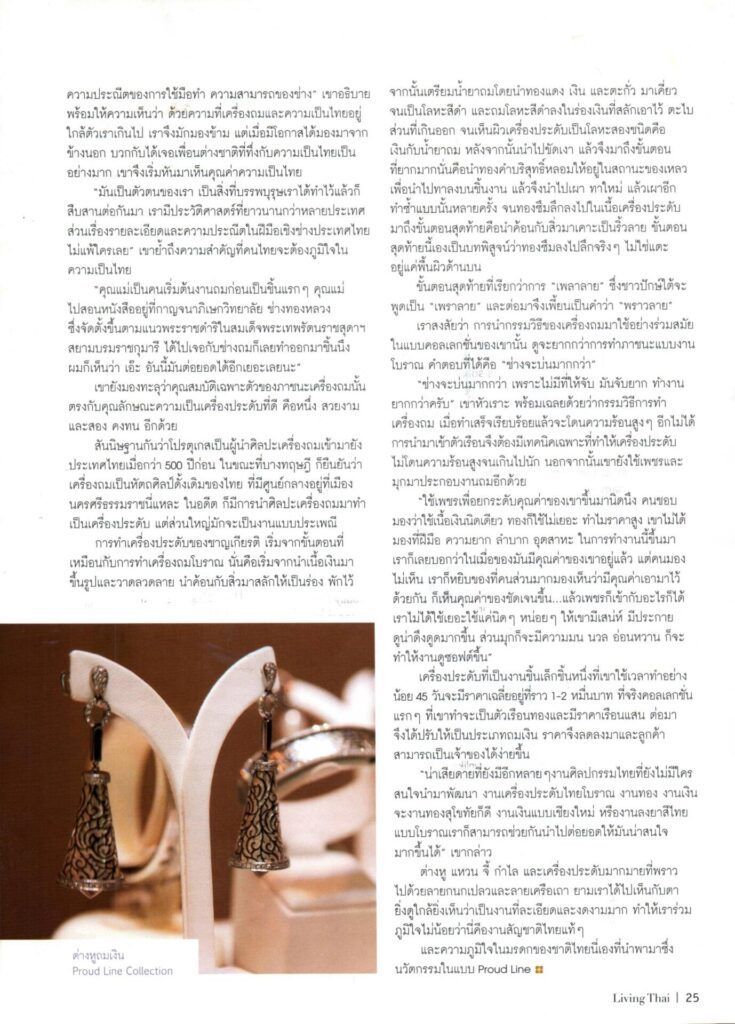
TRENDSETTERS’
Charnkiat Mahantakhun is “Proud to be Thai”
When he released his debut jewellery collection, Proud Line by Bee Bijoux, there were more than a few cocked eyebrows, and audible whispers wondered: how on earth was such a debonair, sans frontieres personality was going to promote anything Thai, leave alone jewellery? “My friends loved to tease me that I didn’t look like a guy who loved anything ‘Thai’,” says Charnkiat Mahantakhun, chucking the very idea with a mirthful chuckle.
To label jewellery “Thai” does not mean the work must retain every crook and cast of ancient craftwork; some adjustments are possible, even desirable, to make the piece come alive for the modern generation. To take an established idea and make it work on something else, that is creativity. In this case, Charnkiat has brought the art of niello to a new audience in way they can appreciate more closely. Historically used in decorating utensils and cutlery of the Siamese nobility, niello has now been appropriated by Charnkiat to make jewellery. And his ornaments are irresistible as a genuine novelty, because they use an ancient medium in a modern context. How modern? Try out the niello USB drive. Better still, wear niello on your ear, neck, wrist or finger. Niello noir is in, darlings, it’s the new cool! “I have two teams of artists. One team comprises experts in the ancient art of niello creation, and the other team specialises in modern application of the jewellery,” explains Charnkiat. “Nowadays Thais no longer wear ancient attire-cum-shoulder cloths. So, it would be very difficult to stay in the market if we still produced ancient jewellery and expected customers to wear them with modern clothing. As a result, we have a few guidelines on how to create a Thai-style jewellery collection that is still perfectly compatible with the modern apparel culture: we must ponder on the designs — how to make them wearable by people of today’s generation, and how to make them proud of the Thainess that we offer.” As an affirmative answer to all these considerations, the Proud Line collection was released in 2007 and the following year won the coveted DEmark Award (Design Excellence Award) from the Department of Export Promotion, Ministry of Commerce. And winning the same award again in 2009 and 2011 only confirmed how aptly this collection has been named. Proud Line, indeed. “It is a matter of great pride for us that our products are appreciated by the public, especially when people actually perceive the true value of niello in our works. Over the passing years, niello works have been on the verge of vanishing from Thai society. Partly because this kind of art is very delicate and very difficult to accomplish. It requires a high level of concentration, perseverance and devotion to the art. That is why few modern artists are keen about it. Considering the amount of time required to complete a niello product, today’s craftsmen would rather make more money by churning out western-style jewellery,” the young designer reveals.
While basking in the limelight of appreciative attention, Charnkiat is quick to give credit where credit is due: he thanks the media, whose supportive exposure helped stir market interest, leading to public acceptance. As a consequence of these products having grown in popularity, artists specialising in niello are gaining more orders from niello-wearers. And art students, awake to the remunerative possibilities present in niello nostalgia, are finding it worthwhile to pursue in-depth study of this art form. Proud Line has opened two outlets in Bangkok — one at K-Village on Sukhumvit Road, and the other at Suvarnabhumi Airport. Even as the 35-year-old artist devotes his time and energy to Proud Line, he is also pursuing a doctorate in Education Technology at Chulalongkorn University, and conducting research on nielloware. He has developed a digital media format, a kind of computerised teacher’s assistant, to let apprentice artists try out, evaluate and improve their skills in a virtual environment, before attempting the real thing. This has proven very useful since the process of making nielloware is a precise and delicate one, highly prone to failure and loss of pricey materials. Let us turn back the clock to when our artist was still studying. Charnkiat Mahantakhun began university as a student of Business Administration. After a while he began to feel this wasn’t quite what he wanted to do in life; so he opted instead to study Multimedia Design at Southern Oregon University in the United States. Not once did he yet think of following in his mother’s occupational footsteps as a jewellery designer. Indeed, he had not an inkling about designing anything, let alone something “Thai”. But now he found himself on the other side of the world, where Thai culture and traditions were considered an exotic rarity. And he thought of the countless days spent in his mother’s atelier watching her make beautiful ornaments. All this inspired in him a sense of pride for his heritage and thus began the first stirrings of an artistic endeavour that shaped up to become the Proud Line. “One thing I’ve learnt — and this is an empirical truth — is that in the Western world, it is only a matter of technological advancement because in that part of the world they have better technology which can control the weight of each piece of ornament, making it smoother and lighter. While in the Eastern world where technology is not the first cup of tea of the day, we compete in skills, neatness and flexibility, all through the means of the artists’ own hands,” he explains. Charnkiat also voices the opinion that, while not excluding other types of Thai crafts, niello work is truly and completely a Thai art form, a point many still neglect to fully
appreciate. Having reflected deeply in this vein, and getting to know many foreign friends who expressed wonderment at such amazing splendour, Charnkiat began to develop a deep and abiding appreciation of the quality of Thai art. “It is who we are. It is what our forefathers, our ancestors had been doing since the beginning of time. It is something that we should be proud of that our country has a history that has outlived many other cultures in the world. As for the skills present among Thai artists, I can say that our artists are second to none,” says Charnkiat, emphasising the importance of Thai culture, in which all Thai people must take pride. “It was my mother who started to produce some niello products while teaching at the Royal Goldsmith College in a project initiated by Princess Maha Chakri Sirindhorn. Upon seeing her work. I thought that niello was a great foundation from which could spring a lot of artistry.” He studied the unique characteristics of nielloware and, in his vivid imagination, he began to clearly see the application of niello in ornaments and jewellery, because niello was not only beautiful but durable too. As for the history of niello in ancient Siam, one popular belief states that niello was brought to Siam by the first Portuguese merchants who arrived in the 15th century. A more likely theory is that niello was already a flourishing craft in Nakhon Si Thammarat during the Srivijaya Empire from the 7 – 13th centuries, long before the Portuguese showed up. A few ancient artifacts serve as historical evidence confirming the existence of nielloware in southern Thailand as ceremonial ornaments. Charnkiat’s jewellery making is not very different from the procedures followed since time immemorial. He starts by heating and shaping the silver, then etches
the desired pattern by gently gouging tiny troughs in the silver with a hammer and chiselette; into these tiny trenches is then poured a quasi-liquid niello amalgam, which is a dark-coloured heated mixture of copper, silver and lead; when the niello amalgam has solidified, the excess niello that has spilled over its gouged trenches is filed away to once again expose the unetched and smooth surface of the silver. The piece is later cleaned and polished in preparation for the next, very important procedure — the application of pure molten gold to the surface under high temperature. This process is repeated as many times as necessary for the golden liquid to seep through the “skin” of the jewellery piece. Then, with hammer and chiselette, another pattern is gouged on the surface, to make sure that the gold has completely fused into the piece and not ju’st to the surface. This last procedure explained above is called “Rao Lai”, a term pronounced by speakers of the southern dialect as “Prao Lai” — and here lies the origin of the name Proud Line, which Charnkiat has given to his collection of niello jewellery. Asked whether it is more difficult to apply the traditional procedures of making nielloware in creating the modern jewellery of his collection, Charnkiat admits that artists do moan about it. “Artists complain a lot” because there is not much surface available whereby to clamp the piece in place, because jewellery pieces are quite small, unlike kitchenware or other household items. “It is definitely more difficult this way,” he agrees, though the accompanying chortle seems already to make light of this exacting exercise. He cautions, though, that once the niello has been applied onto a pattern, the piece must not be allowed to undergo very high temperatures ever again. Therefore, it is quite a hard task to assemble the pieces together without applying too much heat to the piece and this requires special technique. Besides, Charnkiat also uses pearls and diamonds, which certainly add value to his creations. “We use diamond to add some ‘perceivable value’ to the pieces because people tend to look at one aspect only — that we use so little silver and gold. Which makes them ask why the pieces are so expensive. People don’t seem to realise that it takes a lot of skill and patience to make just one piece of these ornaments. But skill and patience are not physically visible. So we need to add something of ‘perceivable value’ — in this case a diamond — to make it more precious and consistent with the set price. Another advantage is that a diamond looks good and gets along with lots of things. We don’t use that many diamonds in our works, only just enough to elicit the enchantment of the beholder. As for pearls, they make the ornament appear sweeter and softer, while the perceivable value is still there to see.” Charnkiat reveals that it takes at least 45 days to finish one tiny piece of jewellery and it costs roughly 10,000 to 20,000 baht. His very first collection was actually made entirely of pure gold — a rather prohibitive prospect today due to the very steep gold prices. So, after certain adjustments in design and processing, he began to produce silver niello. The comparatively lower price tag allows more people to buy the product. “It’s sad to see that there are many more types of Thai arts and crafts still being neglected. Ancient Thai ornamental crafts like Lanna goldsmithy, Sukhothai’s gold craftsmanship, Chiang Mai silversmithy, or even ancient Thai coloured jewellery — all these deserve to be developed and elevated in order to cater to potential customers from the younger generation,” he said. Closely inspecting the earrings, rings, pendants, bracelets and many more ornaments proudly exhibiting classical Thai patterns and images (such as mythical birds and plants), we realise that each millimetre has been magically wrought with great care and precision, thereby displaying a great deal of beauty. Which certainly makes the Thai chest expand with pride — as Thai innovation places Thai identity on a new and modern pedestal of global admiration, thanks in no small part to Proud Line and its creator, Charnkiat Mahantakhun.
Words Suwanna Premsote
Photography Varis Kusujarit
Living Thai Magazine

